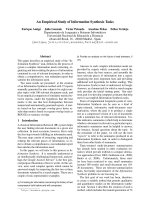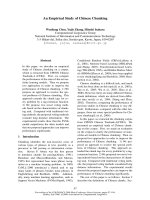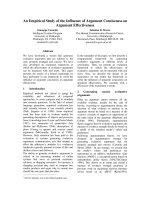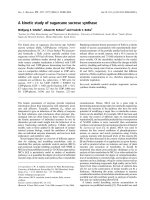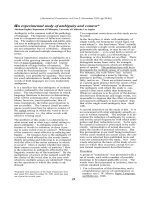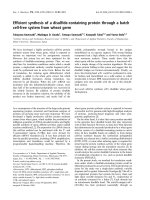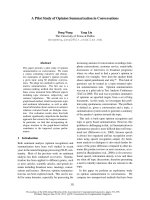Báo cáo khoa học: "Phase i study of ‘dose-dense’ pemetrexed plus carboplatin/radiotherapy for locally advanced non-small cell lung carcinoma" pps
Bạn đang xem bản rút gọn của tài liệu. Xem và tải ngay bản đầy đủ của tài liệu tại đây (276.18 KB, 8 trang )
RESEARCH Open Access
Phase i study of ‘dose-dense ’ pemetrexed plus
carboplatin/radiotherapy for locally advanced
non-small cell lung carcinoma
Xinglei Shen
1
, Albert DeNittis
2
, Maria Werner-Wasik
1
, Rita Axelrod
3
, Paul Gilman
4
, Thomas Meyer
4
, Joseph Treat
5
,
Walter J Curran
1,6
, Mitchell Machtay
1,7*
Abstract
Background: This phase I study investigates the feasibility of carboplatin plus dose-dense (q2-week) pemetrexed
given concurrently with radiotherapy (XRT) for locally advanced and oligometastatic non-small cell lung can cer
(NSCLC).
Methods: Eligible patients had Stage III or IV (oligometastatic) NSCLC. Patient s received XRT to 63 Gy in standard
fractionation. Patients received concurrent carboplatin (AUC = 6) during weeks 1 and 5 of XRT, and pemetrexed
during weeks 1, 3, 5, and 7 of XRT. The starting dose level (level 1) of pemetrexed was 300 mg/m
2
. Following the
finding of dose limiting toxicity (DLT) in dose level 1, an amended dose level (level 1A) continued pemetrexed at
300 mg/m
2
, but with involved field radiation instead of extended nodal irradiation. Consolidation consisted of
carboplatin (AUC = 6) and pemetrexed (500 mg/m
2
) q3 weeks × 2 -3 cycles.
Results: Eighteen patients were enrolled. Fourteen patients are evaluable for toxicity analysis. Of the initial 6
patients treated on dose level 1, two experienced DLTs (one grade 4 sepsis, one prolonged grade 3 esophagitis).
There was one DLT (grade 5 pneumonitis) in the 8 patients treated on dose level 1A. In 16 patients evaluable for
response (4 with oligometastatic stage IV disease and 12 with stage III disease), the median follow-up time is
17.8 months. Thirt een of 16 patients had in field local regional response. The actuarial median survival time was
28.6 months in all patients and 34.7 months (estimated) in stage III patients.
Conclusions: Concurrent carboplatin with dose-dense (q2week) pemetrexed at 300 mg/m
2
with involved field XRT
is feasible and encouraging in patients with locally advanced and oligometastatic NSCLC.
Trial Registration: ClinicalTrials.gov NCT00330044
Background
Concurrent chemoradiation has been established as the
standard of care for non-operable stage III non-small cell
lung cancer (NSCLC) [1-4]. With this approach, the median
survival time is approximately 17 months and about 15% of
patients survive 5+ years. Concurrent combined modality
therapy has improved survival over single modality or
sequential therapy [1-4], b ut overall outcomes remain poor.
The optimal chemotherapy regimen to use with con-
current radiation therapy remains uncertain. Initial
studies of concurrent t reatment have used cisplatin
plus a second drug given at near-systemic doses
for two cycles during RT [1-4]. No platinum based
doublet has clear proven superiority over other regi-
mens. These comb inations have significant toxicity
with high rates of esophagitis, nausea/vomiting, and
myelosuppression.
Alternative less toxic chemotherapy drugs and sche-
dules, most notably weekly carboplatin/paclitaxel regi-
mens have been extensively studied [5-8]. This
regimen has been criticized because safe and feasible
“radiosensitizing” doses of carboplatin (AUC = 1.5 to
2) and paclitaxel (45-50 mg/m2) are well below the
dose intensities considered independently active
* Correspondence:
1
Department of Radiation Oncology, Kimmel Cancer Center, Jefferson
Medical College of Thomas Jefferson University, Philadelphia, USA
Full list of author information is available at the end of the article
Shen et al. Radiation Oncology 2011, 6:17
/>© 2011 Shen et al; licensee BioMed Central Ltd. This is an Open Access article distributed under the terms of the Creative Commons
Attribution License ( whi ch permits unrestricted use, distribution, and repro duction in
any medium, provided the original work is properly cited.
against NSCLC[9]. Thus, while this regimen may have
excellent radiosensitization properties, it likely has lit-
tle effect o n tumor populations outside of the radiation
portal. The solution has been to combine concurrent
chemoradiotherapy with induction [8,10] o r consolida-
tion [4,5] chemotherapy given at systemic doses. This
approach necessarily delays the initiation of either
local or systemic therapy.
In contrast, the new cytoto xic drug pemetrexed has
independent activity against NSCLC and reduced
toxicity [11,12], and may be feasible to deliver at near-
systemic doses with concurrent radiotherapy [13]. Peme-
trexed belongs to the antimetabolite class of antineo-
plastic drugs. It targets multiple molecules within the
folate metabolism pathway, including thymidylate
synthase and dihydrofolate reductase. Preclinical data
support the hypothesis that pemetrexed serves as a
radiosensitizer in addition to having independent activity
against NSCLC in vitro and in vivo [14,15]. A large ran-
domized trial comparing pemetrexed to docetaxel in
second line treatment of metastatic NSCLC showed
similar response and survival with a more favorable toxi-
city profile for pemetrexed [16]. In the first line che-
motherapy setting for advanced NSCLC, a randomized
trial showed that pemetrexed in combination with cis-
platin resulted in equivalent survival to gemcitabine
with cisplatin [17].
Preliminary results of several studies testing peme-
trexed plus radiotherapy have been presented. A phase I
trial showed that pemetrexed at a dose of 500 mg/m2
q3weeks (Weeks 1, 4, and 7) could be combined with a
full course of standard radiotherapy [13]. Recent update
from the CALBG trial #30407 showed that systemic
dose pemetrexed may be combined with systemic dose
carboplatin (AUC = 6) q3weeks with concurrent radia-
tion to 70 Gy with acceptable toxicities. Efficacy data
presented at ASCO 2009 is encouraging, with a median
survival time of 22.3 months [18].
The modest toxicity profile of pemetrexed led us to
consider whether further intensification of pemetrexed
during chemoradiotherapy could be accomplished, with
the long-term goal of improving local and distant con-
trol. This strategy has successfully improved outcomes
in node-positive bre ast cancer [19,20], aggressive n on-
Hodgkin’s lymphoma [21], and ovarian cancer[22]. We
designed and initiated a pilot (phase I) feasibility trial of
dose-dense (q2-week) pemetrexed with systemic dose
carboplatin and concurrent radiotherapy in the treat-
ment of locally advanced and oligometastatic NSCLC.
Methods
This was a prospective, invest igator-initiated clinical
trial, approved by the scientific Clinical Research Com-
mittee of the Kimmel Cancer Center at Thomas
Jefferson University as well as the Internal Review Board
(IRB) of Thomas Jefferson University (TJU). The study
was also approved by the IRB of the participating medi-
cal center, Lankeanu Hospital (Lower Merion, PA), a
member of the Jefferson Health System. Eli Lilly Inc.
supported the study with a grant to Thomas Jefferson
University; however, the study was written, conducted
and analyzed by TJU an d Lankenau investigators and
sponsored by TJU, independently from any corporate
ent ity. The study was monitored by the Kimmel Cancer
Center’s Data and Safety Monitoring Board in addition
to the investigators.
Patients/Eligibility
This study was available to patients with locally
advanced NSCLC who required definitive full dose
radiotherapy as part of their treatment plan. This
included stage IIIA, I IIB and o ligometastatic stage IV
(without diffuse hematogenous metastases) NSCLC.
Patients wit h stage IV NSCLC were only eligible if they
had bulky local-regional disease deemed to require high
dose local radiotherapy and no symptoms from their
extrathoracic disease.
Other eligibility requirements included Zubrod perfor-
mance status 0-1, absence of severe (>10%) weight loss,
FEV1 >1000 cc, serum creatinine < 1.5 mg/dl, serum
bilirubin < 1.5 mg/dl, SGOT < 1.5 times institutional
upper limits of normal, hemoglobin >8.0 g/dl, ANC
>2000 cells/mm
3
, platel ets > 100,000 cells/mm
3
,andno
recent (< 6 months) myocardial infarction, unstable
angina, congestive heart failure or uncontrolled arrhyth-
mia. Exclusion criteria also included prior chemotherapy
for lung cancer and/or prior thoracic radiotherapy that
would result in field overlap.
Radiotherapy
Radiotherapy (RT) planning via 3-dimensional, CT-scan
based planning was required. Intensity modulated radia-
tion therapy (IMRT) was not used. The choice of field
arrangements was left to the discretion of the radiation
oncologist, and typically consisted of two to four confor-
mally planned, coplanar fields designed to minimize
irradiation of the spinal cord and contralateral lung.
Respiratory gating was not used. The protocol-specified
dose of radiotherapy to tumor as defined by CT (and
PET scan where appropriate) was 63 Gy, given in con-
ventional (1.8-2 Gy) once daily fractionation.
The initial protocol design (Dose Level #1) was to
irradiate a large volume to 45 Gy, followed by a cone-
down to the gross tumor (plus a small margin) for an
18 Gy boost. This initial volume w ould include the
gross tumor plus a generous margin (at least 2 cm) and
the comprehensive bilateral mediastinal nodal space
(from the thoracic inlet to at least 5 cm below the
Shen et al. Radiation Oncology 2011, 6:17
/>Page 2 of 8
carina). In some cases, radiotherapy fields included the
inferior mediastinal nodes to the crus of the diaphragm
(if subcarinal nodes were i nvolved) and/or contralateral
hilar nodes (if bilateral mediastinal no des were
involved), based on the principl e of irra diating at least
one echelon of lymph nodes beyond that known to be
grossly involved.
The protocol was subsequently amended in response
to two DLTs to require the use of involved field irradia-
tion from the start of radiotherapy (Dose Level #1A).
Involved field radiotherapy included areas positive by
CT scan and/or PET scan, with an option t o include
area s located geographically between two involved areas
(e.g. inclusion of the ipsilateral hilum if the adjacent
mediastinal nodes are involved). Contralateral mediast-
inal, contralateral hilar and supraclavicular nodes were
no longer electively irradiated.
Chemotherapy/Dose Escalation Plan
The study was designed to use a fixed dose of carbopla-
tin (AUC = 6, based upon the Cockr oft -Gault formula),
during Weeks 1 and 5 of radiotherapy (preferably during
Day 1 or 2 of those weeks). There were no plans to alter
this dose/schedule.
The pemetrexed design of the study was to administer
this drug on a biweekly basis (Weeks 1, 3, 5, and 7) dur-
ing radiotherapy; on Weeks 1 and 5 it would be given
toge ther on the same day with carboplatin. The starting
dose of pemetrexed for the study was 300 mg/m
2
,with
plans to dose escalate to 400 and 500 mg/m
2
in subse-
quent patients based upon analysis of feasibility and
toxicity (these dose escalations did not successfully
occur).
Dose/sch edule modifications were allow ed for toxicity.
If grade 3-4 neutropenia/thrombocytopenia and/or
grade 3 non-hematologic toxicity occurred, all agents
(RT, carboplatin, radiotherapy, and pemetrexed) were to
be held for 1-2 weeks. When toxicity resolved to Grade
0-1, treatment was to be resumed with a reduction in
pemetrexed by 50 mg/m2 (i.e. from 300 mg/m2 to
250 mg/m2). If a second episode of Grade 4 hematolo-
gic or grade 3 non-hematologic toxicity were to occur,
this would be considered a DLT and the patient
removed from study.
Patients who successfully completed carboplatin/
pemetrexed and concurrent radiotherapy were allowed
to continue on to consolidation carboplatin/pemetrexed
after recovering from acute ef fects of c hemoradiother-
apy. The consolidation regimen consisted of 2-3 cycles
of carboplatin (AUC = 6) and pemetrexed (500 mg/m
2
)
q3 weeks. Growth factor (G-CSF or GM-CSF) support
was recommended.
Patients were given a subcutaneous injection of B12
(1000 mcg) before starting study treatment and once
per month while on study. Folic acid (1000 mcg daily)
was also prescribed starting Day 1.
Study Endpoints/Analysis plan
The primary endpoint of the study was dose-limiting
toxicity (DLT), defined as any one of the following ser-
ious adverse events (SAE’ s) as determined by the study
investigators and medical monitor to be the result of
study treatment:
1. Death within 30 days after the completion of radio-
therapy or within 90 days of start of radiotherapy.
2. Grade 4 non-hemato logic toxicity occurring dur-
ing or within 30 days after the completion of radio-
therapy or within 90 days of start of radiotherapy.
3. Grade 3 pulmonary toxicity within 90 days after
the completion of chemoradiotherapy.
4. Prolonged (>14 days) grade 3 esophagitis 30 days
after the completion of radiotherapy or within
90 days of start of radiotherapy preventing the
patient from being able to proceed with anti-cancer
treatment.
5.Inabilitytocompleteatleast54Gyofthoracic
radiotherapy due to toxicity
The Kimmel Cancer Center of Tho mas Jefferson
University assigned an independent medical monitor to
review SAE’ s with the study investigators and help
determine if/when a DLT occurred and if pemetrexed
dose may be escalated (or de-escalated) per study
protocol.
The statistical plan called for dose escalation from
Dose Level #1 (300 mg/m2) to Dose Level #2 (400 mg/
m2) if/when none of the first three or one of the first
six patients enrolled and evaluable experienced a DLT.
A similar plan was made for further escalation beyond
Dose Level #2. If at any given dose level, a second DLT
occurred, the study was to be closed to further accrual,
discussed with the medical monitor and IRB, and modi-
fied in order to assure patient safety.
Secondary endpoints included local tumor response
rates, and progression-free and overall survival. Survival
times were calculated from date of registration on trial.
Results
Accrual/Feasibility
This study enrolled its first patient in April 2006; the
final patient enrolled in April 2008. There were several
time periods where the study was closed for safety/toxi-
city assessment.
Of the 18 patients accrued, two patients were never
treated with study chemoradiotherapy and are not eva-
luable for any study endpoints. Both patients were
found to be fully eligible, signed informed consent, and
Shen et al. Radiation Oncology 2011, 6:17
/>Page 3 of 8
were enrolled using our institution’ s registration
mechanism. One patient withdrew consent and switched
to non-protocol chemoradiotherapy; the sec ond devel-
oped a GI bleed and severe anemia p rior to receiving
any study medication.
Of the remaining 16 patients, two patients are not
evaluable for the primary study endpoint (determination
of DLT). These two pat ients (Pts 9 and 10) were
enrolled onto Dose Level #2 (400 mg/m2 pemetrexed),
based upon what initially appeared to be a favorable
toxicity profile among the first six evaluable patients in
Dose Level #1. However, as patients #9 and 10 were
beginning treatment, a delayed DLT in Dose Level #1
occurred (prolonged esophagitis/weight loss requiring
feeding tube). After discussions among the investigators
and medical monitor, they were offered the option of
withdrawing or continuing with a reduced pemetrexed
dose of 250 mg/m2 (Dose Level # -1). These patients
optedtocontinueatthereducedpemetrexeddose.Of
note, these two patients completed therapy on schedule
with no significant non-hematologic toxicities.
Patient characteristics
Patient characteristics are shown in Table 1. The med-
ian patient age was 70. No patient was considered a
candidate for surgical resection. The median FEV1 was
2.00 L. Most patients had stage III disea se (6 stage IIIA;
6 stage IIIB) and 4 patients had oligomet astatic (3 brain,
1 bone) stage IV disease. Histology was squamous in
3 patients, adenocarcinoma in 9 patients, and not-
otherwise-specified (NOS) in 4 patients.
Treatment compliance
Fourteen patients were evaluable for the study’s primary
endpoints of feasibility and assessment of DLT; all these
patients received both doses of carboplatin (AUC = 6),
and 13 of 14 patients completed their full course of
radiotherapy. All 14 patients received at least 3 of four
planned courses of pemetrexed (7 of 14 received all four
courses; the other 7 missed one course due to neutrope-
nia and/or anemia). Of the 13 patients who completed
radiotherapy, 8 received at least two cycles of adjuvant
chemotherapy and 5 did not (2 developed progressive
disease, 2 had dose limit ing toxicities precluding further
therapy, and 1 developed a pulmonary embolism).
Toxicity
Of the six patients enrolled into Dose Level #1, two
patients developed DLT. One DLT was neutropenic fever,
sepsis and multi-organ failure, which appeared to arise in
the setting of colonic perforation at the site of chronic
diverticulitis. The patient recovered after urgent surgery
and a prolonged hospital course, but was unable to resume
any anti-cancer treatment. The second DLT was a delayed
and prolonged grade 3 esophagitis after completion of con-
current chemoradiation requiring feeding tube placement,
preventing the patient from receiving any additional anti-
cancer treatment. Based on these two DLTs, Dose Level #1
was considered infeasible as originally designed and the
study was amended utilizing reduced radiotherapy fields.
Dose Level #1A enrolled eight patients evaluable for
toxicity. One patient suffered a DLT: an 83 year-old
man with significant underlying COPD developed
Table 1 Patient Characteristics and Treatment Delivery
Patient Age Stage Histology Dose Level XRT dose/Tx time (Gy/days) Concurrent Pemetrexed Dose Received (mg/m
2
)
1TJ 55 IIIB Ad 1 63/45 1150
2ST 72 IIIB Sq 1 63/48 900
3LM 64 IIIA Ad 1 39.6/33* 900
4SR 45 IIIB Ad 1 59.4/57 1200
5MW 54 IV Ad 1 63/47 1200
6SR 75 IIIA Ad 1 63/51 900
7PH 68 IIIB NOS 2/-1 63/55 1300
8JD 72 IIIB Ad 2/-1 63/51 1150
9JB 78 IIIB NOS 1A 63/47 900
10 BS 61 IV NOS 1A 63/49 1200
11 ES 63 IV Ad 1A 63/48 900
12 JB 83 IIIA Sq 1A 63/53 1200
13 EH 73 IV Ad 1A 63/54 1200
14 ML 74 IIIA Ad 1A 63/47 1200
15 CN 74 IIIA Sq 1A 63/49 1200
16 UG 62 IIIA NOS 1A 63/48 1200
*Pt suffered neutropenic fever/sepsis requiring tre atment discontinuation .
Histology: Ad = Adenocarcinoma; Sq = Squamous; NOS = Not-otherwise-specified.
Shen et al. Radiation Oncology 2011, 6:17
/>Page 4 of 8
respiratory d ecompensation one week after completing
chemoradiotherapy, and ultimately died. The treating
physicians i nitially determined that this was ‘unrelated’
to study treatment and primarily related to age and
underlying respiratory insufficiency. However, on com-
prehensive review by the entire study investigation team
and independent medical monitors, it was concluded
that the patient’s death should be considered ‘possibly
related’ to treatment.
The overall toxicity profile of sixteen evaluable patients
is shown in Table 2. The most common toxicity was neu-
tropenia, including 7 cases of grade 3-4 neutropenia.
TherewasoneGrade5toxicityandonepatientwith
Grade 4 non-hematologic toxicity (neutropenic fever/sep-
sis). Three patients developed grade 3 esophagitis. One
patient developed grade 3-4 fatigue. In Dose Level #1, the
rate of any Grade 3 or greater non-hematologic toxicity
was 33% (2/6); in Dose Level #1A, the rate of Grade 3 or
greater non-hematologic toxicity was 25% (2/8).
Response/Efficacy
A total of 15 patients are evaluable for treatment
response and p atterns of failure (Table 3). In-field local-
regional tumor response (partial or complete response)
by RECIST criteria was observed in 14, while the other
patient demonstrated stable disease without evide nce of
in-field progression on serial CT and/or PET scans at
40 months. Three patients developed local-regional
recurrence as the first site of failure. One progressed
just outside of the radio the rapy portal (’marginal miss’)
and a second patient progressed in an elective nodal
region not treated with involved field radiation. These
two patients, each with a small focus of intrathoracic
progression, were treated with additional radiotherapy.
A third patient who progressed within the treatment
field at 22 months was treated with salvage brachyther-
apy. In all, five patients progressed locally a t a median
time of 10 months.
Three patients (20%) without distant metastases at
registration developed distant metastases as the first site
of failure at a median time of 5 months. Four additional
patients (27%) had oligometastatic disease at presenta-
tion, and all four succumbed to progressive systemic
metastases at a median time of 6 months.
There have been nine deaths among the 16 study
patients, seven from metastatic NSCLC, one from
respiratory failure (due to intercurrent disease and/or
treatment complication) and one from an unrelated myo-
cardial infarction. The median follow-up period for a ll
patients is 15.2 months (3 - 40 months) and 24.2 months
for surviving patien ts (12-40 months). Th e one-year
actuarial overall survival rate is 63%, and two-year 56%.
Median survival t ime for all patients was 28.6 months,
and among stage III patients it was not reached, but
Table 2 Acute Toxicity
Toxicity Grade 1-
2
Grade
3
Grade
4
Grade
5
Dose Level #1* (N = 6)
Neutropenia 1 2 1
††
—
Thrombocytopenia 1 1 1
††
—
Anemia 3 1 ——
Esophagitis 3 1 ——
Pneumonitis 2 1 ——
Sepsis ––1
††
–
Fatigue 4 –——
Elevated LFT’s41
††
——
Elevated Creatinine 1 –——
Worst Toxicity Overall 2 3 1 —
Worst non-heme Toxicity
Overall
411—
Dose Level #1A* (N = 8)
Neutropenia 4 3 1 —
Thrombocytopenia 2 1 ——
Anemia 6 1 ——
Esophagitis 5 2 ——
Pneumonitis 3 ——1
§
Sepsis ————
Fatigue 5 — 1
§
—
Elevated LFT’s1———
Elevated Creatinine 1 ———
Worst Toxicity Overall 3 3 — 1
Worst non-heme Toxicity
Overall
41— 1
—
Overall Study Population (N = 16) †
Neutropenia 5 5 2 —
Thrombocytopenia 3 2 1
††
—
Anemia 9 2 ——
Esophagitis 8 3 ——
Pneumonitis 5 1 — 1
§
Fatigue 9 0 1 —
Elevated LFT’s51——
Elevated Creatinine 2 ———
Worst Toxicity Overall 5 6 1
††
1
§
Worst non-heme Toxicity
Overall
821
††
1
§
* Dose Level #1 and Dose Level #1A used the same doses (pemetrexed 300
mg/m2 q2-week); however Dose Level #1 used extended field RT and Dose
Level #1A used involved field RT.
† Overall study population included all of the patients treated in Dose Level #1
and Dose Level #1A, as well as two patients who were re-assigned from Dose
Level #2 (400 mg/m2) to Dose Leve l -I (250 mg/m2) because of safety purposes.
†† Single patient with sepsis and multi-organ failure in the setting of acute
diverticulitis.
§ Elderly (83-year old) patient with COPD, died from respiratory failu re
30 days post-RT.
Shen et al. Radiation Oncology 2011, 6:17
/>Page 5 of 8
estimated at 34.7 months (Figure 1). Median survival
time for oligometastatic patients was 6 months.
Discussion
We demonstrate the feasibility and safety of combining
dose-dense (q2-week) pemetrexed and systemic dose
carboplatin ( AUC = 6) with radiotherapy for NSCLC.
All patients were able to receive both doses of carbopla-
tin and at least three (out of four) doses of pemetrexed
with concurrent radiation. All but one patient was able
to complete radiotherapy. The main toxicity observed in
this study was myelosuppression, primarily manifesting
as neutropenia.
Toxicity was decreased by amending the study to
mandate the use of smaller (involved-field) radiotherapy
treatment plans. We found that 2 of the first 6 patients
enrolled in our study suffered non-hematologic DLT’s
when treated with comprehensive mediastinal irradia-
tion. After changing the radiotherapy planning portion
of our study, non-hematologic DLT’s occurred in 1 of 8
patients. This patient was an 83 year-old man with
severe COPD who died from respiratory decompensa-
tion following completion of chemoradiotherapy. We
conservatively report this as a DLT although intercur-
rent disease played a significant role.
When the study was originally designed (in 2005),
standard RT consisted of comprehensive mediastinal
irradiation to 45-50 Gy followed by a boost to gross
tumor to 60-64 Gy, as used in the Radiation Therapy
Oncology Group (RTOG) clinical trials [2,23,24].
Table 3 Treatment Response and Outcomes Data
Patient Dose Level Initial Local response Distant Metastases Survival Status
1TJ 1 NR/SD None AWD @ 40 mo.
2ST 1 PR Diffuse Mets DOD @ 34 mo.
3LM 1 PR Diffuse Mets DOD @ 15 mo.
4SR 1 CR Diffuse Mets DOD @ 29 mo.
5MW 1 PR Mets at presentation DOD @ 6 mo.
6SR 1 CR None NED @ 26 mo.
7PH 2/-1 CR None AWD @ 26 mo.
8JD 2/-1 PD* None NED @ 27 mo.
9JB 1A CR None NED @ 24 mo.
10 BS 1A PR Mets at presentation DOD @ 9 mo.
11 ES 1A PR Mets at presentation DOD @ 6 mo.
12 JB 1A NA NA DID/DOC @ 3 mo.
13 EH 1A PR Mets at presentation DOD @ 6 mo.
14 ML 1A PR None NCRM @ 9 mo.
15 CN 1A PR None AWD @ 18 mo.
16 UG 1A CR None AWD @ 18 mo.
NR/SD: No Response/Stable Disease.
PR: Partial Response.
CR: Complete Response.
PD*: Progressive Disease (one patient had PD just outside of the radiotherapy field edge).
NA: Not Assessable - one patient is not assessable or evaluable due to early (possibly treatment related) death.
AWD: Alive with Disease
DOD: Died of Disease.
NED: No Evidence of (Active) Disease.
DID/DOC: Died of intercurrent Disease and/or treatment Complications.
NCRM: Non-cancer related mortality (one patient died of a MI while NED).
Figure 1 Kaplan-Meier survival curve. Median survival time for all
patients treated is 28.6 months. For stage III patients, the median
survival time was not reached, but estimated at 34.7 months.
Shen et al. Radiation Oncology 2011, 6:17
/>Page 6 of 8
More recently, data show that outcomes (local control
and survival) are not compromise d by using involved-
field radiotherapy from the start of treatment, and
reduced treatment volume may allow the delivery of
higher radiotherapy dose [25,26].
In contrast to previous chemoradiat ion regimens con-
taining reduced radiosensitizing doses of carboplatin
and paclitaxel, this study investigated the used of sys-
temic doses of carboplatin (AUC = 6), which has inde-
pendent activity in NSCLC. The dose dense pemetrexed
at 300 mg/m
2
also approaches systemic dose of peme-
trexed. Altho ugh our study was not powered for assess-
ment of anti-tumor efficacy, the results of our sur vival
data are very promising with a median survival time of
28.6 months in all patients, and estimated 34.7 months
in stage III patients.
We note that almost all evaluable patients had a clini-
cal local response and at least short term in-field local
control of their cancer. Alth ough pathologic assessment
of local disease was not performed in our study, our
data do support the hypothesis that dose-dense carbo-
platin/pemetrexed is an effective radiosensitization
regimen f or definitive therapy of locally advanced non-
operative NSCLC.
Despite excellent in field control, progression of dis-
ease outside the radiation treatment fields remains
exceedingly common. Our study inc luded four patients
with oligometastatic diease, an d each of these patients
quickly progressed systemically with a median survival
of only 6 months. Three a dditional patients developed
metastatic disease as the first site of recurrence, and
two patients recurred locoregionally outside the treat-
ment field. We hypothesize that this reflects chemore-
sistance in micrometastatic deposits outside of the
radiotherapy fields. With improving local control, the
ability to control micrometastatic d isease has increas-
ing importance in improving overall survival. It is
possible that higher dose intensity of platinum, peme-
trexed and/or addition of a third cytotoxic drug could
be more effective, although at a cost of higher toxicity.
A recent study by Cullen et al. failed to show an
advantage to increased dose intensity of pemetrexed in
advanced/metastatic (platinum-refractory) NSCLC[27].
This study compared 500 mg/m2 q3week versus
900 mg/m2 q3week. It is unclear whether dose intensifi-
cation of pemetrexed using a q2week schedule, or in a
less heavily pre-treated population such as ours, might
yield different results.
Another strategy might be to add a biologic agent
such as a vascular targeting drug or an anti-EGFR agent
to our regimen. The Cancer and Leukemia Group B
(CALGB) study #30407 investigated in a prospective
phase I I randomized trial combining carboplatin/radio-
therapy and pemetrexed (standard 500 mg/m2 q3-week
schedule) with or without cetuximab. Presented in
abstract form at the 2009 ASCO national meeting, the
carboplatin/pemetrexed/RT arm had a promising med-
ian survival time o f 22.3 months, but the addition of
cetuximab did not result in improved survival with a
median survival time of 18.7 months [18].
A complementary strategy may be more careful selec-
tion of semi-customized treatments. Ra ndomized studies
of single agent pemetrexed in second line chemotherapy
treatment of NSCLC and of platinum/pemetrexed in
first line treatment of advanced NSCLC demonstrated
an improved survival in patients with non-squamous
NSCLC, and a worse outcome in patients with squa-
mous histology [16,17]. This difference may be related
to increased expression of thymidylate synthase (TS) in
squamous cancers or other proteins relevant to the tar-
get of pemetrexed[17]. Our study did not collect tissue
to perform this analysis, but evaluation of TS will be
important to future studies of pemetrexed and radiation
in NSCLC.
Conclusions
Dose -dense (q-2week) pemetrexed at a dose of 300 mg/
m2 and carboplatin (AUC = 6) combined with concur-
rent invo lved field radiation i s feasible. It was not feasi-
ble with extended field radiotherapy. Responses are
encouraging and this is a suitable platform for further
development of future combined modality trials.
Acknowledgements
This study was partially supported by a grant from Eli Lilly, Inc.
Author details
1
Department of Radiation Oncology, Kimmel Cancer Center, Jefferson
Medical College of Thomas Jefferson University, Philadelphia, USA.
2
Department of Radiation Oncology, Lankenau Hospital and Lankenau
Institute for Medical Research, Main Line Health System, Pennsylvania, USA.
3
Department of Medical Oncology, Kimmel Cancer Center, Jefferson Medical
College of Thomas Jefferson University, Philadelphia, USA.
4
Department of
Hematology/Oncology, Lankenau Hospital and Lankenau Institute for
Medical Research, Main Line Health System, Pennsylvania, USA.
5
Eli Lilly, Inc.,
Indianapolis, USA.
6
Department of Radiation Oncology, Emory University
Hospital, Atlanta, USA.
7
Department of Radiation Oncology, University
Hospitals, Case Medical Center, Cleveland, USA.
Authors’ contributions
MWW, RA, PG, TM, JT, WJC and MM participated in study design. AD, MWW,
WJC and MM participated in the radiation therapy of patients. RA, PG, TM
participated in the chemotherapy treatment of patients. XS, AD, and MM
participated in data collection. XS and MM performed the data analysis
analysis.
All authors read and approved the final manuscript.
Competing interests
XS, AD, MWW, RA, PG, TM, WJC, MM declare that they have no competing
interests.
JT is employed by Eli Lilly, Inc.
Received: 23 September 2010 Accepted: 16 February 2011
Published: 16 February 2011
Shen et al. Radiation Oncology 2011, 6:17
/>Page 7 of 8
References
1. Curran WJ, Scott CB, Langer CJ, et al: Long-term benefit is observed in a
phase III comparison of sequential vs concurrent chemo-radiation for
patients with urnsected stage III NSCLC: RTOG 9410. [Abstract]. Proc Am
Soc Clin Oncol (ASCO) 2003, 22:621.
2. Fournel P, Robinet G, Thomas P, et al: Randomized phase III trial of
sequential chemoradiotherapy compared with concurrent
chemoradiotherapy in locally advanced non-small cell lung cancer:
Groupe Lyon-Saint-Etienne d’Oncologie Thoracique-Grouope Francais de
Pneumocancerologie NPC 95-01. J Clin Oncol 2005, 23:5910-7.
3. Furuse K, Fukuoka M, Kawahara M: Phase III study of concurrent versus
sequential thoracic radiotherapy in combination with mitomycin,
vindesine, and cisplatin in unresectable stage III non-small cell lung
cancer. J Clin Oncol 1999, 17:2692-9.
4. Gandara DR, Chansky K, Albain KS, et al: Long-term survival with
concurrent chemoradiation therapy followed by consolidation docetaxel
in stage IIIB non-small-cell lung cancer: a phase II Southwest Oncology
Group Study (S9504). Clin Lung Cancer 2006, 8:116-21.
5. Belani CP, Choy H, Bonomi P, et al: Combined chemoradiotherapy
regimens of paclitaxel and carboplatin for locally advanced non-small
cell lung cancer: a randomized phase II locally advanced multi-modality
protocol. J Clin Oncol 2005, 23:5883-91.
6. Belani CP, Ramanathan RK: Combined-modality treatment of locally
advanced non-small cell lung cancer: incorporation of novel
chemotherapeutic agents. Chest 1998, 113:53S-60S.
7. Kim DW, Shyr Y, Shaktour B, Akerley W, Johnson DH, Choy H: Long term
follow up and analysis of long term survivors in patients treated with
paclitaxel-based concurrent chemo/radiation therapy for locally
advanced non-small cell lung cancer. Lung Cancer 2005, 50:235-45.
8. Vokes EE, Herndon J, Kelley MJ, et al: Induction chemotherapy followed
by chemoradiotherapy compared with chemoradiotherapy alone for
regionally advanced unresectable stage III Non-small-cell lung cancer:
Cancer and Leukemia Group B. J Clin Oncol 2007, 25:1698-704.
9. Belani CP, Barstis J, Perry MC, et al: Multicenter, randomized trial for stage
IIIB or IV non-small cell lung cancer using weekly paclitaxel and
carboplatin followed by maintenance weekly paclitaxel or observation. J
Clin Oncol 2003, 21:2933-9.
10. Socinski MA, Blackstock AW, Bogart JA, et al: Randomized phase II trial of
induction chemotherapy followed by concurrent chemotherapy and
dose-escalated thoracic conformal radiotherapy (74 Gy) in sage III non-
small cell lung cancer: CALGB 30105. J Clin Oncol 2008, 26:2457-63.
11. Cohen MH, Johnson JR, Wang YC, Sridhara R, Pazdur R: FDA drug approval
summary: pemetrexed for injection (Alimta) for the treatment of non-
small cell lung cancer. Oncologist 2005, 10:363-8.
12. Zinner RG, Fossella FV, Herbst RS: Pemetrexed in advanced NSCLC: a
review of the clinical data. Oncology 2004, 18:54-62.
13. Seiwert TY, Connell PP, Mauer AM, et al: A phase I study of pemetrexed,
carboplatin, and concurrent radiotherapy in patients with locally
advanced or metastatic non-small cell lung or esophageal cancer. Clin
Cancer Res 2007, 13:515-22.
14. Bischof M, Weber KJ, Blatter J, Wannenmacher M, Latz D: Interaction of
pemetrexed disodium (ALIMTA, multitargeted antifolate) and irradiation
in vitro. Int J Radiat Oncol Biol Phys 2002, 52:1381-8.
15. Teicher BA, Chen V, Shih C, et al: Treatment regimens including the
multitargeted antifolate LY231514 in human tumor xenografts. Clin
Cancer Res 2000, 6:1016-23.
16. Hanna N, Shepherd FA, Fossella FV, et al: Randomized phase III trial of
pemetrexed versus docetaxel in patients with non-small-cell lung cancer
previously treated with chemotherapy. J Clin Oncol 2004, 22:1589-97.
17. Scagliotti GV, Parikh P, von Pawel J, et al: Phase III study comparing
cisplatin plus gemcitabine with cisplatin plus pemetrexed in
chemotherapy-naive patients with advanced-stage non-small-cell lung
cancer. J Clin Oncol 2008, 26:3543-51.
18. Govindan R, Bogart J, Wang X, et al: Phase II study of pemetrexed,
carboplatin, and thoracic radiation with or without cetuximab in
patients with locally advanced unresectable non-small cell lung cancer:
CALGB 30407. [Abstract]. J Clin Oncol 2009, 27:7505.
19. Citron ML, Berry DA, Cirrincione C, et al: Randomized trial of dose-dense
versus conventionally scheduled and sequential versus concurrent
combination chemotherapy as postoperative adjuvant treatment of
node-positve primary breast cancer: first report of Intergroup Trial
C9741/Cancer and Leukemia Group B Trial 9741. J Clin Oncol 2003,
21:1431-9.
20. Kummel S, Krocker J, Kohls A, et al: Randomised trial: survival benefit and
safety of adjuvant dose-dense chemotherapy for node-positive breast
cancer. Br J Cancer 2006, 94:1237-44.
21. Pfreundschuh M, Trumper L, Kloess M, et al: Two-weekly or 3-weekly
CHOP chemotherapy with or without etoposide for the treatment of
young patients with good-prognosis (normal LDH) aggressive
lymphomas: results of the NHL-B1 trial of the DSHNHL. Blood 2004,
104:626-33.
22. Isonishi S, Yasuda M, Takahashi F, et al: Randomized phase III trial of
conventional paclitaxel and carboplatin (c-TC) versus dose-dense weekly
paclitaxel and carboplatin (dd-TC) in women with advanced epithelial
ovarian, fallopian tube, or primary peritoneal cancer: Japanese
Gynecologic Oncology. [Abstract]. J Clin Oncol 2008, 26s:5506.
23. Choy H, Swann S, Walter C, Whipple G, Demas W, Ettinger D: A Phase I
trial of Gemcitabine, Carboplatin or Gemcitabine, Paclitaxel and
Concurrent Radiation Therapy Followed by Consolidative Gemcitabine
and Carboplatin for Inoperable Stage III Non-Small Cell Lung Cancer: An
RTOG Study. [Abstract]. J Clin Oncol 2005, 23s:646s.
24. Werner-Wasik M, Swann S, Curran W Jr: A Phase II Study of Cetuximab
(C225) In Combination with Chemoradiation (CRT) in Patients (PTS) with
Stage IIIA/B Non-Small Cell Lung Cancer (NSCLC): An Interim Overall
Toxicity Report of the RTOG 0324 Trial. [Abstract]. J Clin Oncol 2005,
23s:654s.
25. Bradley J, Graham MV, Winter K, et al: Toxicity and outcome results of
RTOG 9311: a phase I-II dose-escalation study using three-dimensional
conformal radiotherapy in patients with inoperable non-small-cell lung
carcinoma. Int J Radiat Oncol Biol Phys 2005, 61:318-28.
26. Yuan S, Sun X, Li M, et al: A randomized study of involved field
irradiation versus elective nodal irradiation in combination with
concurrent chemotherapy for inoperable stage III nonsmall cell lung
cancer. Am J Clin Oncol 2007, 30:239-44.
27. Cullen MH, Zatloukal P, Sorenson S, et al: A randomized phase III trial
comparing standard and high-dose pemetrexed as second-line
treatment in patients with locally advanced or metastatic non-small-cell
lung cancer. Ann Oncol 2008, 19:939-45.
doi:10.1186/1748-717X-6-17
Cite this article as: Shen et al.: Phase i study of ‘dose-dense’
pemetrexed plus carboplatin/radiotherapy for locally advanced non-
small cell lung carcinoma. Radiation Oncology 2011 6:17.
Submit your next manuscript to BioMed Central
and take full advantage of:
• Convenient online submission
• Thorough peer review
• No space constraints or color figure charges
• Immediate publication on acceptance
• Inclusion in PubMed, CAS, Scopus and Google Scholar
• Research which is freely available for redistribution
Submit your manuscript at
www.biomedcentral.com/submit
Shen et al. Radiation Oncology 2011, 6:17
/>Page 8 of 8

